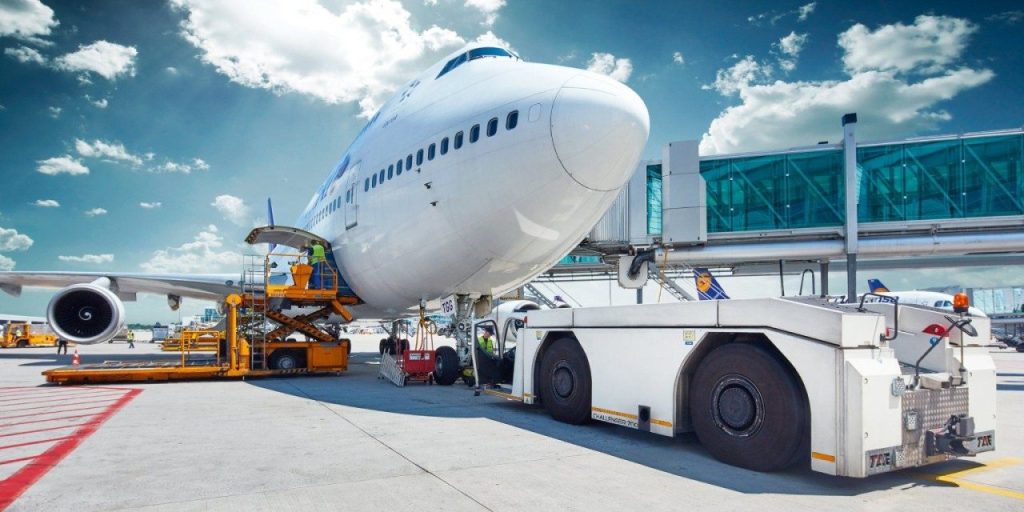5 Min Read
Table of contents

The aviation industry is a complex ecosystem. From monitoring asset conditions to managing baggage handling systems and other ground operations, the challenges are immense. Inefficiencies in asset conditions and operations can have far-reaching consequences, including costly delays, compromised safety, and diminished customer satisfaction. In an industry where every minute counts, streamlining operations is paramount.
Effective streamlining requires advanced Enterprise Asset Management (EAM) solutions like IBM Maximo. IBM Maximo application suite, an advanced asset management solution, can help airports streamline aviation operations by centralizing data, automating processes, and providing real-time visibility into operations
What is IBM Maximo for Airports and Aviation?

IBM’s Maximo Enterprise Asset Management (EAM) system is tailored for aviation companies and airport operations and provides specialized capabilities for efficiently scheduling and managing maintenance operations for aircraft fleets, airport equipment, and infrastructure.
It allows organizations to configure aircraft and equipment engineering models, create operator maintenance programs, plan flight schedules for maintenance routings, manage inventory and warranties, and perform real-time risk assessments and failure reporting.
Maximo also enables airports to optimize operations across all departments by automating workflows, measuring KPIs, managing compliance inspections, monitoring IoT sensor data, and providing a unified platform for execution. It helps maintain regulatory compliance, passenger safety, and peak operational efficiency at airports.
What are The Challenges in Airport Maintenance?

Airport maintenance operations face significant challenges due to the critical nature and complexity of the infrastructure and assets involved.
Three major challenges include:
Complex Asset Management
Airports consist of a vast array of complex assets like runways, taxiways, terminals, a baggage handling system, fueling equipment, and more. Managing the maintenance of all these diverse asset types, tracking their conditions, scheduling downtimes, and ensuring availability is extremely complex. Airports cannot afford any unplanned breakdowns or periods of high asset inoperability.
Safety and Security Concerns
The top priority for any airport is maintaining high levels of safety and security at all times. Maintenance lapses that could impact operations and put passengers at risk are simply unacceptable. Strict safety protocols and regulations must be followed meticulously across all maintenance activities. Security vulnerabilities from any equipment failures must be prevented.
Keeping Up With Evolving Regulatory Compliance
The airport and aviation industry is highly regulated to ensure operational safety and efficiency. Airports must maintain strict compliance with frequently evolving requirements and standards from regulators like the Federal Aviation Administration (FAA). Failing to meet these necessary regulations can result in heavy fines, penalties, or even forced groundings. Manually tracking and implementing regulatory changes is extremely challenging.
What is the Maximo Tool Used for in Travel and Transportation Asset Management System?

IBM Maximo is an industry-leading enterprise asset management (EAM) solution extensively used by transportation and aviation organizations to streamline their maintenance operations and asset lifecycle management.
Some key use cases of Maximo in this sector include:
1. Improved Asset Visibility & Tracking
Maximo offers real-time visibility into the status and location of all assets, from vehicles and equipment to infrastructure. This enhanced tracking capability ensures that every asset is accounted for, which reduces the risk of loss and enables management to make more informed decisions.
2. Enhancing Operational Efficiency
By automating routine tasks and providing detailed insights into asset performance, Maximo helps airport facilities streamline operations. This leads to faster turnaround times, fewer delays, and efficient use of resources, ultimately improving overall operational efficiency.
3. Streamlined Work Order Management
Maximo simplifies the creation, assignment, and tracking of work orders. This ensures that maintenance tasks are completed promptly and accurately, reducing downtime and keeping operations running smoothly.
4. Predictive Maintenance for Enhanced Reliability
Leveraging data analytics, Maximo enables predictive maintenance, identifying potential issues before they become critical problems. This proactive approach enhances the reliability of assets, reduces unexpected failures, and extends the lifespan of equipment.
5. Inventory Management and Procurement Optimization
Maximo optimizes inventory levels by accurately forecasting demand and streamlining procurement processes. This reduces excess stock and minimizes shortages, ensuring that the right parts and materials are always available when needed.
6. Comprehensive Reporting and Compliance
Maximo provides robust reporting tools that help organizations meet regulatory requirements and maintain compliance. Detailed reports and analytics facilitate continuous improvement and ensure that all operations adhere to industry standards.
7. Cost Optimization and Budget Control
By capturing critical data and offering detailed insights into asset performance and maintenance costs, Maximo aids in budget control and cost optimization. Organizations can better allocate resources, reduce unnecessary expenditures, and maximize their return on investment.
How Do You implement Maximo EAM (Enterprise Asset Management) in Airports?

Implementing Maximo EAM (Enterprise Asset Management) in airports and related facilities involves undertaking a structured approach to ensure seamless integration and maximum benefit. Here’s a detailed guide through the essential steps:
STEP 1: Initial Assessment and Planning
The first step in implementing Maximo EAM is conducting a thorough initial assessment and planning phase. This involves evaluating the current state of asset management at the airport, identifying key pain points, and defining the goals of the implementation.
During this phase, stakeholders from various departments—maintenance, operations, IT, and finance—should collaborate to understand their specific needs and expectations.
A detailed project plan is then developed, outlining the timeline, resources, budget, and milestones. Risk assessments and mitigation strategies should also be part of this planning process to address potential challenges early on.
STEP 2: Configuration and Customization
Once the initial assessment is complete, the next step is configuring and customizing Maximo to align with the airport’s specific requirements. Maximo’s flexibility allows it to be tailored to fit unique operational processes. This involves setting up asset hierarchies, defining workflows, configuring user permissions and roles, and integrating with existing systems such as ERP, IoT devices, and other airport management systems.
Customization might also include developing specific functionalities that cater to the unique needs of airport operations. Throughout this phase, it is crucial to engage with end-users to ensure that the system configuration supports their daily tasks and improves their efficiency.
STEP 3: Training and Change Management
Implementing a new EAM system like Maximo requires significant change management to ensure user adoption and minimize disruption. Comprehensive training programs should be developed for all user levels—from administrators and managers to end-users. Training can include hands-on workshops, online courses, and user manuals.
Additionally, a change management strategy should be put in place to address the cultural and operational changes that come with the new system. This might involve regular communication updates, support from leadership, and a feedback mechanism to address concerns and suggestions from users. Effective change management helps in a smooth transition and fosters a positive attitude toward the new system.
STEP 4: Go Live and Continuous Improvement
The final step is the go-live phase, where Maximo is deployed in a live operational environment. This phase should be carefully managed with a clear go-live checklist, including final data migration, system testing, and validation of configurations. Effective testing after implementing Maximo is crucial to address any immediate issues that arise.
Post-go-live, continuous improvement is essential. This involves monitoring system performance, collecting user feedback, and making iterative improvements to the system. Regular audits and reviews should be conducted to evolve with the changing needs of the airport.
Conclusion
In today’s complex and demanding aviation landscape, having a robust enterprise asset management system is critical for airports to maintain efficient operations, ensure compliance, and provide a seamless passenger experience. IBM Maximo has emerged as the leading EAM solution tailored specifically for the aviation and transportation industries.
By leveraging Maximo’s powerful capabilities like asset tracking, streamlined work order management, predictive maintenance, inventory optimization, and comprehensive reporting, airports can maximize asset reliability and uptime while minimizing operational costs and disruptions. It is one of the most suitable platforms for airports looking to streamline maintenance steering programs, flight scheduling, and real-time asset monitoring.
However, successfully implementing Maximo requires careful planning, configuration, and change management. This is where experienced IBM partners like Banetti can provide immense value. As a premier Maximo consulting firm, Banetti has years of expertise in steering EAM implementations for aviation clients across the globe.
With Banetti’s partnered approach, airports can experience a smooth transition while fully unleashing the transformative potential of IBM Maximo for streamlining operations and soaring to new heights of efficiency and profitability.


